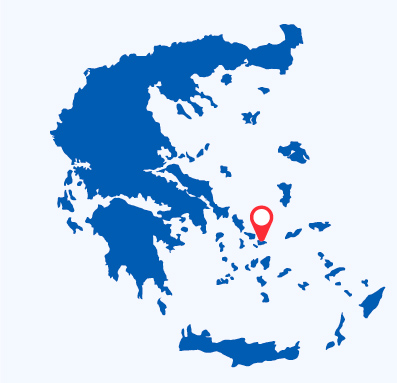Mykonos
Not just jet set or nightlife, but also a wonderful island full of natural beauty, art and culture
And here we are at the queen of Greece, Mykonos Island!
Compared to Ibiza for its transgressive and crazy fun, it is one of the most sought after Greek islands for a holiday that attracts thousands of people every year. We find it in the Cyclades Archipelago and together with the island of Santorini they are the only ones to have an international airport.
A renowned destination, where everything has a price (and what a price) but which will win you over from the moment you set foot there. Yes, because Mykonos is not just jet set or nightlife, it is also a wonderful island full of natural beauty, art and culture.
According to Greek mythology, its name derives from the son of Anio, King of Delos and grandson of the illustrious Apollo. According to legend, it is considered the place where the Gigantomachy ended with Heracles' victory over the Giants and it is thought that the rocks around Mykonos are the bodies of the colossi.
It presents a typical Mediterranean territory with lush vegetation, large fertile areas of citrus and olive trees, all surrounded by idyllic beaches bathed by a clear and transparent sea with shades of blue up to emerald, turquoise and azure. Its highest peak is Profiti Elias (in Greece all the highest peaks are called that) and it expands for about ninety square kilometers with a maximum length of twenty kilometers and a width of fifteen. A small island but one that offers many things to do and see where day merges with night and where you sleep little.
You choose a holiday in Mykonos for its nature, because it has an energy of its own, for the fun and worldliness, to be shocked at times, because it is crazy, cosmopolitan and glamorous but also because it is simply beautiful. It has the reputation of being frequented only by homosexual or LGBT people but this is absolutely not true, ok gay tourism is very present but it is also suitable for families with children or couples, on the other hand there are plenty of beaches, clubs and quiet places there are so many you simply need to choose.
Let's start with its capital Mykonos Town to the west. In the seventies it was a mecca for the hippie movement where everything was simple and cheap, today it has become the most stateless seaside town in all of Greece. Sought after by VIPs and complete strangers, she has managed to transform herself and enchant everyone. Close to a slope is a classic village with labyrinthine mazes that in the past served as a deterrent to sea raiders, houses in blinding white lime with blue windows, streets that seem designed in gray and white tones, small churches, super luxury shops, cafés, trendy restaurants, traditional taverns and views to immortalize in the perfect souvenir photo. In Mykonos Town there are also sophisticatedly designed accommodations, pharaonic villas with swimming pools and homes that once belonged to humble fishermen transformed into art centers. Despite this sumptuous ostentation, however, Mykonos Town still manages to have that pure feel where everything is possible.
One of the busiest areas is undoubtedly Little Venice which you absolutely must not miss. To the east of Mykonos Town near the old port is a neighborhood that is very reminiscent of our Venice and this is the reason for its name. Ancient houses overlooking the sea from their foundations in the water, with a thousand colors where in 1700 wealthy captains and merchants lived with a view of the sublime Aegean. A magical place that offers one of the most beautiful sunsets to be experienced sitting in one of its elegant and delicious venues with a cocktail in hand watching the sun give way to darkness without saying a word but getting lost in your thoughts and in the magic of twilight. Famous artists and photographers from all over the world gather here and immortalize the ethereal beauty of Little Venice in their own way. There are also exclusive clubs where you can wait for the sunrise and gourmet restaurants where you can satisfy your senses.
The windmills of Mykonos are a “must to do” during your stay. Also called Kato Myli we find them on the top of a hill west of the capital in the Kastro area. Identification signs of Mykonos date back to the 16th century and for over 400 years they were the island's major economic source as it was once one of the largest producers of wheat, also exporting it outside the nation. Once decommissioned, they were preserved in the best possible way, so much so that they became one of the most beautiful panoramic points from which to observe the sea and wait for the sunset. Of the original sixteen, five remain and only one called Bonis can be visited, which has come back to life with a curious museum of photographs.
Regular and mythical guest of Mykonos is the pelican Petros, a true icon. You can find him (not the original but his successor), nonschalantly wandering around the alleys and who will not mind accepting a snack from you.
For a moment of history, go on an excursion to the island of Delos, considered sacred where Apollo and Artemis were born. It is recognized as a UNESCO world heritage site and preserves ruins dating back to the Hellenistic period. In the Roman period it was an important religious center with a very prosperous economy. It is said that no mortal could ever be born or die on Delos, so much so that those who were dying were transferred to the island of Rineia to preserve the sanctity of the place.
Don't let yourself be influenced by what is said and read about Mykonos, it is not a place of perdition, certainly transgressive and a little bizarre but it still remains a wonderful island waiting to be discovered.

The best facilities of Mykonos
Selected hotels and apartments that you can book with us
Why book a holiday in Mykonos with us?
- For us, every person is unique and consequently so is their holiday.
- Every quote you request is personalized and tailor-made
- We take care of everything, including guaranteed 24-hour assistance
